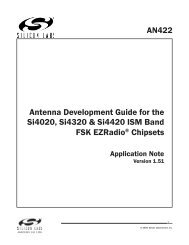C8051F326/7 - Silicon Labs
C8051F326/7 - Silicon Labs
C8051F326/7 - Silicon Labs
Create successful ePaper yourself
Turn your PDF publications into a flip-book with our unique Google optimized e-Paper software.
<strong>C8051F326</strong>/7<br />
enabled, the value of the stop bit for the oldest FIFO byte will be presented in RBX0. When the parity function<br />
is enabled (PE0 = ‘1’), hardware will check the received parity bit against the selected parity type<br />
(selected with S0PT[1:0]) when receiving data. If a byte with parity error is received, the PERR0 flag will be<br />
set to ‘1’. This flag must be cleared by software. Note: when parity is enabled, the extra bit function is not<br />
available.<br />
13.3.3. Multiprocessor Communications<br />
UART0 supports multiprocessor communication between a master processor and one or more slave processors<br />
by special use of the extra data bit. When a master processor wants to transmit to one or more<br />
slaves, it first sends an address byte to select the target(s). An address byte differs from a data byte in that<br />
its extra bit is logic 1; in a data byte, the extra bit is always set to logic 0.<br />
Setting the MCE0 bit (SMOD0.7) of a slave processor configures its UART such that when a stop bit is<br />
received, the UART will generate an interrupt only if the extra bit is logic 1 (RBX0 = 1) signifying an<br />
address byte has been received. In the UART interrupt handler, software will compare the received<br />
address with the slave's own assigned address. If the addresses match, the slave will clear its MCE0 bit to<br />
enable interrupts on the reception of the following data byte(s). Slaves that weren't addressed leave their<br />
MCE0 bits set and do not generate interrupts on the reception of the following data bytes, thereby ignoring<br />
the data. Once the entire message is received, the addressed slave resets its MCE0 bit to ignore all transmissions<br />
until it receives the next address byte.<br />
Multiple addresses can be assigned to a single slave and/or a single address can be assigned to multiple<br />
slaves, thereby enabling "broadcast" transmissions to more than one slave simultaneously. The master<br />
processor can be configured to receive all transmissions or a protocol can be implemented such that the<br />
master/slave role is temporarily reversed to enable half-duplex transmission between the original master<br />
and slave(s).<br />
Master<br />
Device<br />
Slave<br />
Device<br />
RX TX RX TX<br />
Slave<br />
Device<br />
RX TX<br />
Figure 13.6. UART Multi-Processor Mode Interconnect Diagram<br />
122 Rev. 1.1<br />
Slave<br />
Device<br />
RX TX<br />
V+


